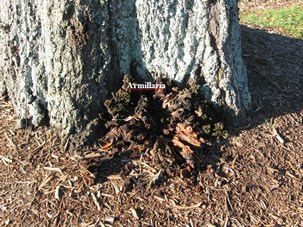 Description: There are many different types of root rot affecting both urban and forest trees. High soil moisture content and high temperatures are common factors. They manifest themselves in different ways but one sure sign of root rot is mushroom-like fungi growing at the base of the tree.
Action: For long-term control of root rot plants must be kept away from poorly drained areas. Resistant cultivars must be chosen and chemical control used consistently. The following is a glimpse of the most common types of root rot:
The most common root rot pathogen on woody plants, Phytophthora is a serious and widespread fungus disease that is hard to control. It affects a wide range of plants, including azalea, rhododendron, dogwood, camellia, mountain laurel, juniper, white pine, boxwood and others. The disease is not as common on well-drained soils and this is the best control for it.
Symptoms vary by plant but yellowing of the leaves is common, with possible purple coloration and defoliation occurring. Discoloration of the inner bark and wood at the base of the infected plant is usually present and can be seen if the outer bark is scraped away. Reddish-brown liquid may bleed from the cankered area.
Armillaria is commonly called oak root rot or shoestring root rot and is becoming one of the most deadly soil borne fungal diseases of peach in the US. It survives in the soil for up to a century and is well protected under the bark of infected root pieces. Symptoms of Armillaria can take up to two years to be noticed. Infected trees appear to be drought stressed, due to loss of fine feeder roots. Leaf cupping and reduced shoot extension are common and fruit will be smaller and turn red prematurely. Honey colored mushrooms may appear at the base of the tree in late summer. By the next year, the tree is dead. White, paper-thick, fan-shaped sheets of the fungus appear around the bottom of the trunk and have a strong mushroom smell. Tree removal is recommended.
Ganoderma root rot has distinctive plate-like fruiting bodies with shiny, reddish purple tops and cream colored edges. These conks, as they are commonly called, are produced at the base of the infected tree. Most oaks are affected by ganoderma. The fungus enters through a wound so preventing injuries is a top priority. Since positive identification is made by the ‘conks’, decay is well advanced by then. Further decay analysis should be considered to see how advanced the decay has spread.
Thank you for reviewing this information. Schneider Tree Care is committed to preserving and enhancing the quality of your property through tree care education and services. We employ professionally trained and certified arborists who are available to meet with you for a consultation at no charge.
If you have any questions or need additional information regarding the health of your trees, please contact us.
Description: There are many different types of root rot affecting both urban and forest trees. High soil moisture content and high temperatures are common factors. They manifest themselves in different ways but one sure sign of root rot is mushroom-like fungi growing at the base of the tree.
Action: For long-term control of root rot plants must be kept away from poorly drained areas. Resistant cultivars must be chosen and chemical control used consistently. The following is a glimpse of the most common types of root rot:
The most common root rot pathogen on woody plants, Phytophthora is a serious and widespread fungus disease that is hard to control. It affects a wide range of plants, including azalea, rhododendron, dogwood, camellia, mountain laurel, juniper, white pine, boxwood and others. The disease is not as common on well-drained soils and this is the best control for it.
Symptoms vary by plant but yellowing of the leaves is common, with possible purple coloration and defoliation occurring. Discoloration of the inner bark and wood at the base of the infected plant is usually present and can be seen if the outer bark is scraped away. Reddish-brown liquid may bleed from the cankered area.
Armillaria is commonly called oak root rot or shoestring root rot and is becoming one of the most deadly soil borne fungal diseases of peach in the US. It survives in the soil for up to a century and is well protected under the bark of infected root pieces. Symptoms of Armillaria can take up to two years to be noticed. Infected trees appear to be drought stressed, due to loss of fine feeder roots. Leaf cupping and reduced shoot extension are common and fruit will be smaller and turn red prematurely. Honey colored mushrooms may appear at the base of the tree in late summer. By the next year, the tree is dead. White, paper-thick, fan-shaped sheets of the fungus appear around the bottom of the trunk and have a strong mushroom smell. Tree removal is recommended.
Ganoderma root rot has distinctive plate-like fruiting bodies with shiny, reddish purple tops and cream colored edges. These conks, as they are commonly called, are produced at the base of the infected tree. Most oaks are affected by ganoderma. The fungus enters through a wound so preventing injuries is a top priority. Since positive identification is made by the ‘conks’, decay is well advanced by then. Further decay analysis should be considered to see how advanced the decay has spread.
Thank you for reviewing this information. Schneider Tree Care is committed to preserving and enhancing the quality of your property through tree care education and services. We employ professionally trained and certified arborists who are available to meet with you for a consultation at no charge.
If you have any questions or need additional information regarding the health of your trees, please contact us. 




